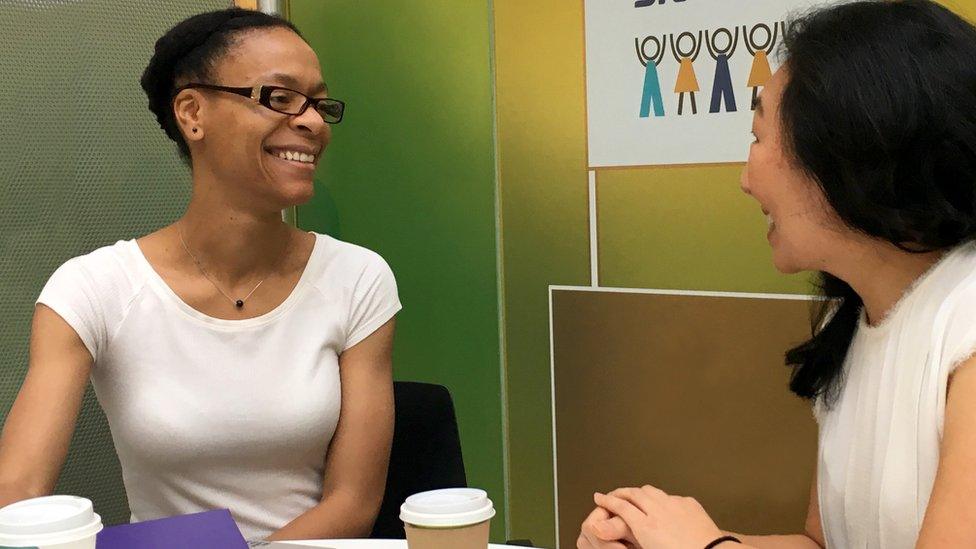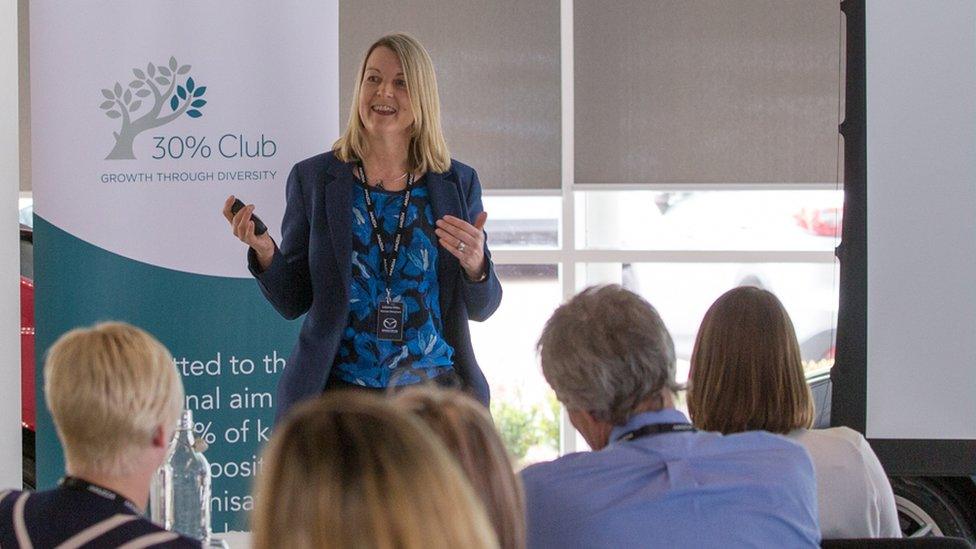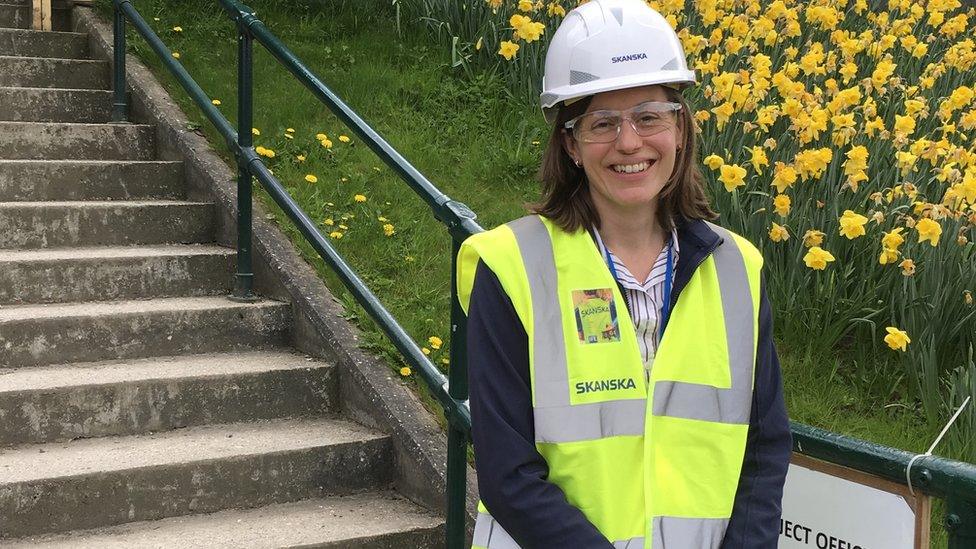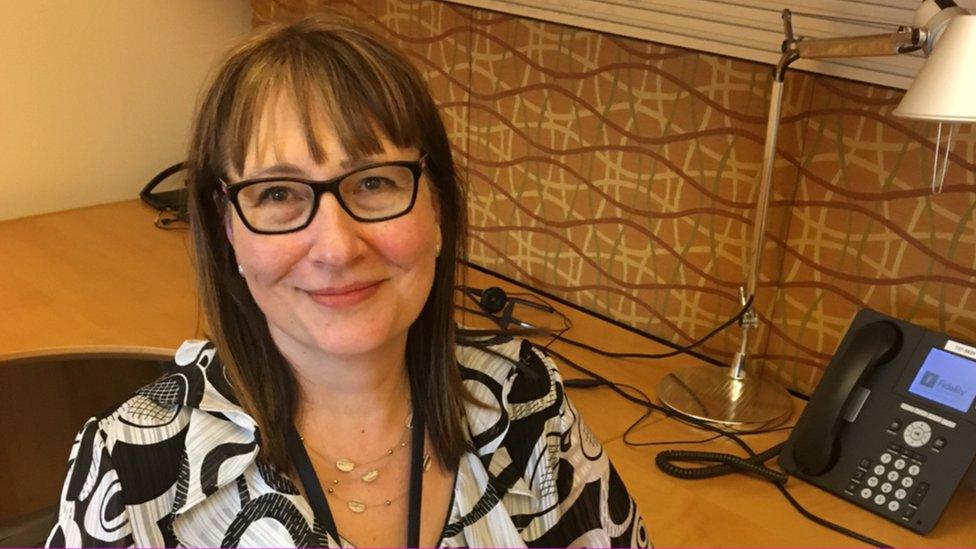Taking a break? The £1.7bn career gap
- Published

Skanska diversity manager Israil Bryan (l) says returnships have helped the construction company to plug some skills shortages
There are plenty of things on a CV that can put off recruiters.
Having a gap on your work history shouldn't be one of them - but the challenges faced by women returning to the workplace costs the UK an estimated £1.7bn a year in lost economic output.
So what can be done to address this black hole?
Julianne Miles co-founded Women Returners to connect firms with candidates who want to get back into work but have a lengthy gap on their CV.
Like an internship, a "returnship" is a placement at a company ranging from six weeks to six months. Where it differs is that returners come in at a paid, high level position following a minimum of two years out of the workplace.
Formerly a high-level marketing executive for Diageo, Julianne took a four-year career break when her children were born before retraining as a psychologist. Her initial goal for Women Returners was to counteract the negative stereotypes surrounding career breaks.
"We were initially driven by the social goal of making sure a career break didn't mean career suicide. I was aware that everything you read at the time was very negative - that if you took a break you couldn't get back into a high-level corporate role. And you could see the reality of that [on the ground] - it was very hard to get back in."
'Career break penalty'
She points out that the "career break penalty" means it's not just the economy that is getting a raw deal.

Chartered psychologist Julianne Miles founded Women Returners after taking a break from the workplace and changing careers
Almost half a million professional women who are currently on care-related career breaks are likely to come back to work in the future. Of those, three in five will move into a lower skilled or lower paid role than the job they had before, reducing their earnings by up to a third, according to PwC research last year.
A further 29,000 will be underemployed - not working as many hours as they would like to. If this penalty was addressed it would add an average of £4,000 on to the salary of each returner.
But Women Returners is not a charitable initiative. Julianne estimates the hiring rate following each programme is 50-85% and points out the companies involved gain access to an untapped pool of talent.
What's more, the multiplier effect of their combined £1.1bn in extra earnings and increased spending power would lead to a £1.7bn increase in UK economic output.
Yet only a tiny fraction of companies offer these schemes.
Tania Ash has just joined Enfield Council's six-month returnship programme as a web architect. After 20 years working in software development for private companies, she took two years out to care for her father, who had been diagnosed with dementia, and look after her baby daughter.

Tania Ash found it hard to rejoin the IT industry after taking time out to spend with daughter Marie
"I have a business background and when I decided to continue my career I was looking for an opportunity with flexible working hours," she says. "It was really hard to find that in the IT industry because it's very rapid, so this was a great opportunity for me to return to the industry."
'Good for both sides'
And not all returners are sitting behind a desk. Engineer Kate Young, 37, took a seven-year career break before starting her placement at Skanska last year when her younger child started school. She has since become a senior engineer at the company.
"The Skanska job was the first to hit all the boxes. It was part-time, location-wise it was flexible and it was relevant to my engineering skills," she says. "I had heard some horror stories from people with big gaps in their CV where the initial [recruitment] filter just puts them straight in the bin."
But she says a returnship is "good for both sides".
"Going in for three months on a returnship means people do not expect you to immediately get there, and they know you have your family life. You know that if it's a disaster you can think, 'well, I've tried it and it doesn't work right now,' so it takes the pressure off."

Kate Young is now employed by Skanska as a senior engineer
The Skanska returnship is open to both women and men who have had a career break. Israil Bryan, the firm's diversity and social programme manager, says running a returnship programme has helped Skanska solve many problems.
"There is a lack of diversity in the construction industry, and there are skill gaps in some core technical areas like engineering and quantity surveying," she says.
"Within Skanska we sought to address both these things - to bring quality people into our business but also people from other industries with core skills that could complement us."
Change of attitude
There are many reasons why people find themselves taking a career break.
Natalie Lang, 49, left her 20-year career in financial services to set up her own childcare business. When she decided to return to the City, recruiters were reluctant to take her on.
"When I started looking for jobs and I was dealing with recruiters, they were very reluctant to put my CV forward when there were other candidates already doing the job, because they felt they had a better chance of getting the position," she says.
But Natalie found financial services firm Fidelity's returner programme online, and now has a permanent role at the company as a business risk manager.

"Recruiters were reluctant to put my CV forward," says Natalie Lang
While Julianne Miles's Women Returners project is still relatively small-scale, it is undeniably gaining momentum. The number of programmes offered have grown from three in 2014 to 27 announced for 2017 so far.
In the March 2017 Budget, the government allocated £5m for "return to work" schemes. But what our society should aim for, Julianne says, is for returnships to become less significant, as the attitude towards career breaks becomes more accepting.
"It's not just about returners - it's about opening the minds of companies to people who have had career breaks more broadly.
"I would like to see returnships continue because it reduces risks on both sides but we are also bringing these role models into organisations. There are only a tiny percentage of people in organisations that have taken career breaks so people can see them and think, 'why are we prejudiced against people who have taken career breaks?'"
- Published6 April 2017

- Published3 March 2017

- Published23 January 2017

- Published6 March 2017
